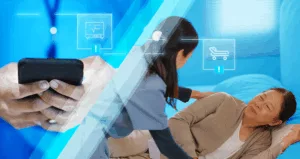To read: ~ 6 minutes
If you’re responsible for deploying a communications system in a hospital, here’s what Ericka Carter (MSN, RN), Clinical Informatics Specialist at Connexall wants you to remember:
Behind every alert, every workflow change, every technology decision is a patient whose life depends on it working.
For Carter, whose background is in both emergency nursing, informatics, and change management, she sees a direct line of impact. “You’re caring for the people caring for patients,” she says, and your goal should be to implement communication systems that reflect the needs of staff, their environment, and those patients who will ultimately benefit.
(If only it were that easy.)

Bridging the Communication Tool Gap While Overcoming Change Resistance
Within any given hospital or healthcare organization you’re sure to find a complex web of communication systems, and most likely: a clinical staff who are inherently resistant to change. Hospitals are living organisms. Each department develops its own communication tools and workflows tailored to their specific needs, which create silos that impede efficient patient care coordination.
Carter has seen this problem in her work as an informatics specialist, “There’s often disparate systems that have to be unified into one space. Bedside nurses need something different than L&D nurses, and often they’re using different tools to communicate.”
These communication workarounds create non-standard workflows that don’t translate beyond individual teams, resistance from staff who fear disrupting patient care, and information overload from multiple unintegrated channels. The hard truth: the systems clinicians are using to protect the consistency of patient care might actually be detrimental to it.

Human-Centered Implementation Through Systematic Observation and Trust-Building Resistance
As an antidote, Carter thinks about tech from a uniquely human perspective.
“It’s critical for us to design technology that will be easy to use, efficient, and also sustainable.” She says, “It’s got to be embedded into the workflow of the clinicians.”
For Carter, successful implementation requires understanding existing workflows through direct observation before introducing changes. This sustained observation builds trust and allows her to demonstrate value through listening to needs, rather than imposing solutions.
If you’re a clinical informatics specialist, nursing leader, or part of a healthcare implementation team, you can use Carter’s techniques—grounded in human factors engineering—to overcome resistance to change while ensuring patient safety and operational efficiency throughout your implementation.

The Process: 5-Steps to Trust-Based Change
This five-step process is designed to help you implement healthcare communication systems that clinical staff will actually adopt and use long term—avoiding what Carter calls the “shiny toy” effect, where new technology gets initial enthusiasm but is quickly abandoned.
Step 1: Pre-Implementation Assessment and Stakeholder Preparation
Action steps: Review unit goals, quality metrics, safety metrics, and staff roles before any observation begins.
As a nurse herself, Carter understands how sensitive clinicians can be to interlopers. There’s instinctual suspicion: why are you here? What am I going to have to do differently because of you? To counteract this, Carter recommends a pre-implementation prep phase to align leadership on focused areas where communication gaps already exist.
In this phase, you’ll make initial assessments and focus entirely on the hospital’s current needs.
Step 2: Structured Direct Observation Across Multiple Contexts
Action steps: Document who answered each alert, response times, and what interrupted their workflow.
“Observe during a day shift where it’s properly staffed,” says Carter, “then observe a night shift and on the weekend. Are there variations in the staffing model?” Pay special attention to workarounds, when staff create their own processes to fill gaps. These workarounds reveal critical system failures that must be addressed, not simply replicated in your new system.
Ask: why did they create this workaround? What wasn’t working that forced them to fill the gap?
Step 3: Trust-Building Through Listening and Transparency
Action steps: Determine if resistance stems from past safety events, efficiency concerns, or change fatigue.
Building trust is a key component of Carter’s process. You could deliver the world’s best communication system, targeted to the exact right gaps in communication, but without trust: no one is going to use it.
The key to building a trusting relationship with clinical staff? “Listen, listen, listen!” Says Carter, “Listen to their concerns, and why they might be resistant.” Then, focus on those who will be most impacted and share your own observations in real-time during debriefs to demonstrate transparency. Tell them what you noticed and what you’ve seen, without judgment.
Step 4: Systematic Change Implementation with Feedback Loops
Action steps: implement start-stop-continue documentation to clarify expectations.
As you begin to implement your technology, create start-stop-continue documentation that clearly outlines: what communication methods to stop using, what new processes to start, and what existing workflows to continue. This eliminates confusion about which tools to use for specific communications.
Then lean on designated “Super Users” and create clear escalation processes for them to share any issues that they’re experiencing or hearing from their peers.
Step 5 – Post-setup: Track, listen, learn, and troubleshoot
Action steps: define your “measure of success” beyond technical usage tracking.
For Carter, proof of success is in the voices of users. “It’s the verbal feedback,” she says—that’s how she knows it’s working. “It’s the expression of ‘oh my, this has been so helpful,’ it’s that they’re feeling less overwhelmed, and not getting alert fatigue from any of their notifications.”
Define your own measures of success, and if you’re not getting there, go back to the early steps: observe, gather feedback, listen and respond.
Sustainable Adoption Through Embedded Workflows
When changes align with natural workflow patterns and meet clinicians where they are, you will likely see dramatic improvement in compliance and adoption.
Once you begin listening, you may find that even minor changes can create a big impact. At one client hospital, clinical staff weren’t completing a required piece of documentation. In her observation, Ericka noticed that the sentence with the word “required” was at the bottom of the document. She suggested they move it to the top, within the eyeline of the clinicians.
“Compliance instantly changed because of it,” says Carter. “We went from 65% to nearly 95% compliance just by moving a line of text.”
Carter’s observation-to-implementation process foregrounds the humans working in the hospital. Beyond the immediate workflow improvements, organizations see improved interdisciplinary collaboration, reduced response times, and decreased communication errors. Most importantly, staff report feeling less overwhelmed and more confident they’re receiving the right information at the right time.
Remember: culture change must come from inside. If frontline staff aren’t heard and embedded in the process, your new technology won’t be successful. “Clinicans want to be clinicians,” Carter says, “They don’t want to have to be tech savvy. They just want to do their jobs.”
And for all of them, that job comes down to one thing: keeping patients safe.


